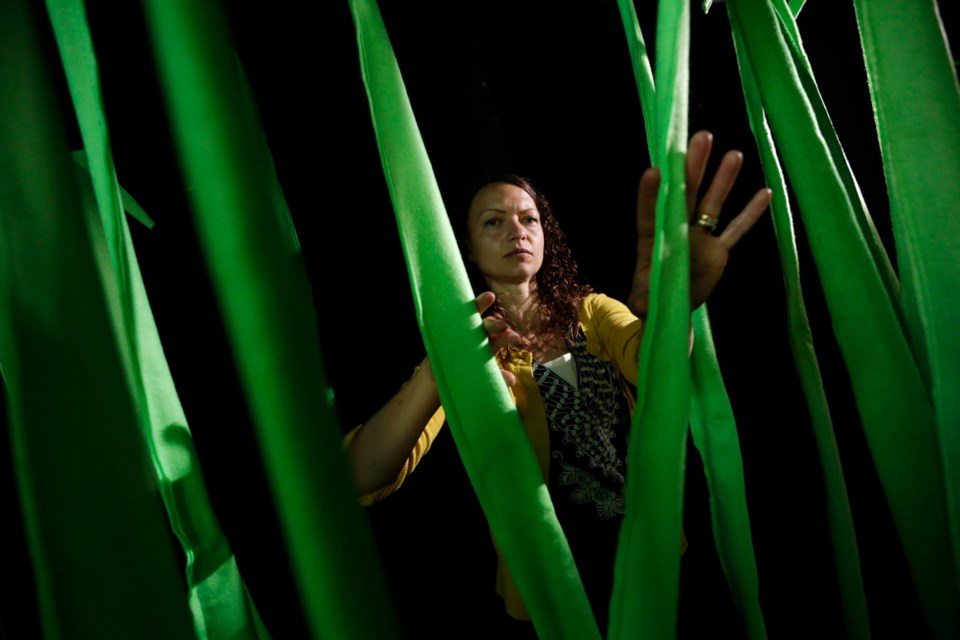What: Amalie Atkins’ We Live on the Edge of Disaster and Imagine We Are in a Musical
Where: Open Space
When: Opening today, 7 p.m. (Dance party at 9 p.m.) Runs to July 27.
Admission: Free
Inside a black screening tent at the centre of Open Space, one of the weird worlds in artist Amalie Atkins’ short films has already escaped the screen.
The ground is covered in rich, black earth. Tiny holes punched in the roof of the tent allow in light that shines like twinkling stars. And flanking the sides, bulrushes sewn from felt reach skyward in a way that would make Jim Henson proud.
Onscreen, a pigtailed young woman explores a prairie landscape inhabited by crafty creatures through a narrative that unfolds in a dark way.
Scenes from a Secret World, as the work is named, is one of several pieces in the Saskatoon artist’s ongoing series We Live on the Edge of Disaster and Imagine We Are in a Musical.
If one thing is clear, it’s that Atkins is the proud owner of a healthy imagination. That imagination is earning her increased attention lately, including a nomination for the 2013 Sobey Art Award and a spot in last year’s Oh, Canada show at the Massachusetts Museum of Contemporary Art.
Now she’s introducing Victoria audiences to the fruits of it — often in the form of silent films made intimate through handcrafted details — as Open Space artist-in-residence.
But she says she didn’t have access to the kind of technology to make it a reality, growing up in rural Manitoba.
“I didn’t have a camera when I was a kid, but I would totally plan out these sequential scenarios,” she said. “That’s my first memory of working like that.”
That included staging little scenes in the forest — miniature campfires with miniature little chairs — and acting surprised when she and her younger sister stumbled upon them later. She told her sister the Littles must have been there, referring to a children’s book series that followed a family of miniature people.
“Apparently, that frightened her,” Atkins said.
Since then, Atkins has developed her technique. After graduating from the Alberta College of Art and Design in Calgary, she moved to Saskatoon nine years ago for a short-term contract and never left.
Though she has honed her craft, working in Saskatoon is not entirely unlike her childhood exercises, she said.
“I grew up on a farm, so there was lots of space and lots of creative time. So I think the work that I do now, and living in Saskatoon, I kind of feel like I’ve come full circle in a way,” she said.
“Sometimes when I’m shooting, it totally reminds me of those experiences. It’s just now I have a camera to record things, and obviously they’re more elaborate situations and stories than when I was a kid, but it feels familiar, too.”
More than make-believe storytelling, however, Atkins’ creations are winning attention for merging artistic esthetics. Like classic films, they open with credits — but each letter in the credit is cut from felt and moves into place through stop motion. There’s no speech, but the story unfolds with piano and xylophone music that helps it along. While the narratives unfold like pieces of folklore, her hand-crafted costumes, sets and props make them personal.
But Atkins, who has woven together strands of discarded footage from past projects for some of the pieces in this series, says the storyline is one of the last pieces of the puzzle.
“All of the stories really do start with an image,” she said. “I think it’s the process of figuring out what all the links are between the images — that’s sort of how the story emerges.”
And while she’s constructed worlds from her own imagination, she said she hopes audiences engage with their own.
“I think it’s accessing your own imagination and intuition and coming to your own conclusions. That’s what I’m hoping for.”
